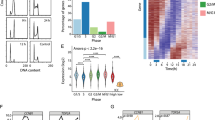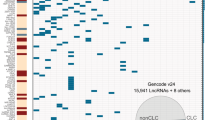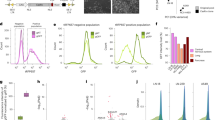Abstract
Mammalian genomes contain thousands of loci that transcribe long noncoding RNAs (lncRNAs)1,2, some of which are known to carry out critical roles in diverse cellular processes through a variety of mechanisms3,4,5,6,7,8. Although some lncRNA loci encode RNAs that act non-locally (in trans)5, there is emerging evidence that many lncRNA loci act locally (in cis) to regulate the expression of nearby genes—for example, through functions of the lncRNA promoter, transcription, or transcript itself3,6,7,8. Despite their potentially important roles, it remains challenging to identify functional lncRNA loci and distinguish among these and other mechanisms. Here, to address these challenges, we developed a genome-scale CRISPR–Cas9 activation screen that targets more than 10,000 lncRNA transcriptional start sites to identify noncoding loci that influence a phenotype of interest. We found 11 lncRNA loci that, upon recruitment of an activator, mediate resistance to BRAF inhibitors in human melanoma cells. Most candidate loci appear to regulate nearby genes. Detailed analysis of one candidate, termed EMICERI, revealed that its transcriptional activation resulted in dosage-dependent activation of four neighbouring protein-coding genes, one of which confers the resistance phenotype. Our screening and characterization approach provides a CRISPR toolkit with which to systematically discover the functions of noncoding loci and elucidate their diverse roles in gene regulation and cellular function.
This is a preview of subscription content, access via your institution
Access options
Access Nature and 54 other Nature Portfolio journals
Get Nature+, our best-value online-access subscription
$29.99 / 30 days
cancel any time
Subscribe to this journal
Receive 51 print issues and online access
$199.00 per year
only $3.90 per issue
Buy this article
- Purchase on Springer Link
- Instant access to full article PDF
Prices may be subject to local taxes which are calculated during checkout




Similar content being viewed by others
Accession codes
References
Guttman, M. et al. Chromatin signature reveals over a thousand highly conserved large non-coding RNAs in mammals. Nature 458, 223–227 (2009)
Cabili, M. N. et al. Integrative annotation of human large intergenic noncoding RNAs reveals global properties and specific subclasses. Genes Dev. 25, 1915–1927 (2011)
Wang, K. C. et al. A long noncoding RNA maintains active chromatin to coordinate homeotic gene expression. Nature 472, 120–124 (2011)
Engreitz, J. M. et al. The Xist lncRNA exploits three-dimensional genome architecture to spread across the X chromosome. Science 341, 1237973 (2013)
Kretz, M. et al. Control of somatic tissue differentiation by the long non-coding RNA TINCR. Nature 493, 231–235 (2013)
Anderson, K. M. et al. Transcription of the non-coding RNA upperhand controls Hand2 expression and heart development. Nature 539, 433–436 (2016)
Engreitz, J. M. et al. Local regulation of gene expression by lncRNA promoters, transcription and splicing. Nature 539, 452–455 (2016)
Paralkar, V. R. et al. Unlinking an lncRNA from its associated cis element. Mol. Cell 62, 104–110 (2016)
Konermann, S. et al. Genome-scale transcriptional activation by an engineered CRISPR–Cas9 complex. Nature 517, 583–588 (2015)
O’Leary, N. A. et al. Reference sequence (RefSeq) database at NCBI: current status, taxonomic expansion, and functional annotation. Nucleic Acids Res. 44, D733–D745 (2016)
König, R. et al. A probability-based approach for the analysis of large-scale RNAi screens. Nat. Methods 4, 847–849 (2007)
Johannessen, C. M. et al. A melanocyte lineage program confers resistance to MAP kinase pathway inhibition. Nature 504, 138–142 (2013). 10.1038/nature12688
Praskova, M., Xia, F. & Avruch, J. MOBKL1A/MOBKL1B phosphorylation by MST1 and MST2 inhibits cell proliferation. Curr. Biol. 18, 311–321 (2008)
Skalska, L., Beltran-Nebot, M., Ule, J. & Jenner, R. G. Regulatory feedback from nascent RNA to chromatin and transcription. Nat. Rev. Mol. Cell Biol. 18, 331–337 (2017)
Fulco, C. P. et al. Systematic mapping of functional enhancer–promoter connections with CRISPR interference. Science 354, 769–773 (2016)
Liu, S. J . et al. CRISPRi-based genome-scale identification of functional long noncoding RNA loci in human cells. Science 355, aah7111 (2017)
Sanjana, N. E. et al. High-resolution interrogation of functional elements in the noncoding genome. Science 353, 1545–1549 (2016)
Zhu, S. et al. Genome-scale deletion screening of human long non-coding RNAs using a paired-guide RNA CRISPR–Cas9 library. Nat. Biotechnol. 34, 1279–1286 (2016)
Joung, J. et al. Genome-scale CRISPR–Cas9 knockout and transcriptional activation screening. Nat. Protocols 12, 828–863 (2017)
Langmead, B., Trapnell, C., Pop, M. & Salzberg, S. L. Ultrafast and memory-efficient alignment of short DNA sequences to the human genome. Genome Biol. 10, R25 (2009)
Li, B. & Dewey, C. N. RSEM: accurate transcript quantification from RNA-Seq data with or without a reference genome. BMC Bioinformatics 12, 323 (2011)
Trapnell, C., Pachter, L. & Salzberg, S. L. TopHat: discovering splice junctions with RNA-Seq. Bioinformatics 25, 1105–1111 (2009)
Rao, S. S. et al. A 3D map of the human genome at kilobase resolution reveals principles of chromatin looping. Cell 159, 1665–1680 (2014). 10.1016/j.cell.2014.11.021
Consortium, E. P. ; ENCODE Project Consortium. An integrated encyclopedia of DNA elements in the human genome. Nature 489, 57–74 (2012)
Felsenstein, J. & Churchill, G. A. A Hidden Markov Model approach to variation among sites in rate of evolution. Mol. Biol. Evol. 13, 93–104 (1996)
Konieczkowski, D. J. et al. A melanoma cell state distinction influences sensitivity to MAPK pathway inhibitors. Cancer Discov. 4, 816–827 (2014)
Barbie, D. A. et al. Systematic RNA interference reveals that oncogenic KRAS-driven cancers require TBK1. Nature 462, 108–112 (2009)
Barretina, J. et al. The Cancer Cell Line Encyclopedia enables predictive modelling of anticancer drug sensitivity. Nature 483, 603–607 (2012)
Acknowledgements
We thank M. Guttman, C. M. Johannessen and M. Ghandi for helpful discussions and insights; A. Sayeed, R. Deasy, A. Rotem and B. Izar for generating the primary patient melanoma cell lines; and R. Belliveau, R. Macrae and the Zhang laboratory for support and advice. J.M.E. is supported by the Fannie and John Hertz Foundation. O.A.A. is supported by a Paul and Daisy Soros Fellowship and National Defense Science and Engineering Fellowship. J.S.G. is supported by a DOE Computational Science Graduate Fellowship. N.E.S. is supported by the NIH through NHGRI (R00-HG008171). J.B.W. is supported by the NIH through NIDDK (F32-DK096822). C.P.F. is supported by the National Defense Science and Engineering Graduate Fellowship. E.S.L. is supported by UM1HG008895 and funds from the Broad Institute. F.Z. is a New York Stem Cell Foundation-Robertson Investigator. F.Z. is supported by the NIH through NIMH (5DP1-MH100706 and 1R01-MH110049), NSF, Howard Hughes Medical Institute, the New York Stem Cell, Simons, Paul G. Allen Family, and Vallee Foundations; and James and Patricia Poitras, Robert Metcalfe, and David Cheng.
Author information
Authors and Affiliations
Contributions
J.J., S.K. and F.Z. conceived and designed the study. J.J. and S.K. conducted the screen. J.J., V.K.V. and J.S.G. performed validation experiments. N.E.S. and J.B.W. performed ATAC–seq and ChIP experiments. J.J. analysed data. O.O.A. and F.A. analysed clinical datasets. J.M.E., C.P.F. and E.S.L. helped with lncRNA experimental design and interpretation. Y.-Y.T., C.H.Y. and J.S.B. generated primary patient melanoma cell lines. J.J., J.M.E., E.S.L. and F.Z. wrote the paper with help from all authors.
Corresponding authors
Ethics declarations
Competing interests
The authors have filed a patent application related to this work. F.Z. is an advisor for Editas Medicine and Horizon Discovery.
Additional information
Publisher's note: Springer Nature remains neutral with regard to jurisdictional claims in published maps and institutional affiliations.
Extended data figures and tables
Extended Data Figure 1 Genome-scale activation screen for lncRNA loci involved in vemurafenib resistance.
a, Scatterplots showing lncRNA-targeting and non-targeting sgRNA frequencies after vemurafenib (vemu) or control treatment from n = 4 infection replicates. b, Scatterplot showing enrichment of sgRNAs targeting six candidate lncRNA loci. c, RIGER P values of the candidate lncRNA loci. d, RIGER P values for the top 100 hits from the previous SAM protein-coding gene screen9 compared to the SAM lncRNA loci screen. e, For each candidate lncRNA locus, ten sgRNAs were designed to target the proximal promoter region (800 bp upstream of the TSS). The relationship between the highest sgRNA enrichment in vemurafenib-treated compared to control condition across screening bioreps (n = 4) and respective spacer position suggests that sgRNAs targeting closer to the annotated TSS are not necessarily more effective, consistent with previous results9.
Extended Data Figure 2 Validation of candidate lncRNA loci for vemurafenib resistance.
Vemurafenib resistance for A375 cells transduced with SAM and individual sgRNAs targeting the top 16 candidate lncRNA loci normalized to a non-targeting (NT) sgRNA. All values are mean ± s.e.m. with n = 4. ****P < 0.0001; ***P < 0.001; **P < 0.01.
Extended Data Figure 3 Activation of candidate lncRNA loci appears to mediate vemurafenib resistance by regulating expression of nearby genes.
a, Heat map showing expression of genes and signature markers for BRAF inhibitor sensitivity (top), expression of candidate lncRNA loci (middle), and RNA-seq signature of gene expression changes upon activation of candidate lncRNA loci (bottom) in 113 different BRAF(V600) patient melanoma samples (primary or metastatic) from The Cancer Genome Atlas. All associations are measured using the information coefficient (IC) between the index and each of the features and P values are determined using a permutation test. Panels show Z-scores. b, Vemurafenib resistance of A375 cells overexpressing cDNAs encoding each candidate lncRNA or protein-coding gene normalized to GFP. GPR35 and LPAR1 are positive controls identified previously9. The same set of sgRNAs targeted TCONS_00012395 and TCONS_00011252; NR_034078 and NR_034079; TCONS_00015940_1 and TCONS_00015940_2. c, Expression of NR_109890 and its neighbouring gene EBF1 after SAM activation of NR_109890. All values are mean ± s.e.m. with n = 4. ****P < 0.0001; ***P < 0.001; *P < 0.05. ns, not significant.
Extended Data Figure 4 Topological domain in the EMICERI locus is consistent across cell types.
Hi-C data and topological domain annotations (dotted lines) in the EMICERI locus from seven cell lines23. Heat map shows KR-normalized contact matrix at 5-kb resolution. Domain annotations for chromosome 9 were not available in K562, but the same topological domain structure is evident.
Extended Data Figure 5 Dosage-dependent upregulation of the EMICERI locus is specific to activation of EMICERI at its conserved regulatory element.
a, TopHat alignment of RNA-seq paired-end reads suggests that EMICERI is located at chr9:27,529,917–27,531,782 and EMICERII at chr9:27,535,71–27,540,711 (UCSC hg19) (Supplementary Note 6). A375 ATAC-seq and phastCons conservation scores for primates, placental mammals, and vertebrates at the EMICERI locus. Scale bar, 1 kb. b, Expression of EMICERI and its neighbouring genes MOB3B, IFNK, EQTN and C9orf72 after transduction with sgRNAs targeting SAM to the promoters of neighbouring genes. All values are mean ± s.e.m. with n = 4. ****P < 0.0001; ***P < 0.001; **P < 0.01; *P < 0.05. ns, not significant. ND, not detected.
Extended Data Figure 6 Activation of EMICERI mediates vemurafenib resistance through MOB3B.
a, Expression of the neighbouring genes or EMICERI or EMICERII after cDNA overexpression compared to GFP control. b, cDNA overexpression of top hits from the SAM protein-coding gene screen for vemurafenib resistance (GPR35 and LPAR1)9 or MOB3B compared to GFP control. c, Vemurafenib dose response curves for A375 cells overexpressing cDNA or GFP control. d, Vemurafenib half maximal inhibitory concentration (IC50) for the same conditions as in c. e, ATARiS gene-level scores from the Achilles Project that reflect genetic vulnerabilities of A375 cells. Lower ATARiS gene-level scores indicate stronger dependency on the gene. Rank of MOB3B, 1,084; IFNK, 3,078; EQTN, 15,939. All values are mean ± s.e.m. with n = 4. ****P < 0.0001; **P < 0.01; *P < 0.05. ND, not detected.
Extended Data Figure 7 Activation of EMICERI mediates vemurafenib resistance in melanoma cell lines.
a–c, Western blots of A375 cells stably overexpressing MOB3B cDNA or GFP control after vemurafenib or control (DMSO) treatment. For gel source data, see Supplementary Fig. 1. d, Expression of EMICERI and MOB3B after SAM activation in different melanoma cell lines. e, Vemurafenib dose response curves for EMICERI activation in different melanoma cell lines. f, Vemurafenib half maximal inhibitory concentration (IC50) for the same conditions as in e. All values are mean ± s.e.m. with n = 4. ****P < 0.0001; ***P < 0.001; **P < 0.01; *P < 0.05. ns, not significant.
Extended Data Figure 8 EMICERI expression is strongly correlated with MOB3B expression and vemurafenib sensitivity in melanoma cell lines and patient samples.
a, Heat map showing expression of genes in the EMICERI locus in 113 different BRAF (V600) patient melanoma samples (primary or metastatic) from The Cancer Genome Atlas. Samples are sorted by EMICERI expression. b, Heat map showing expression of genes in the EMICERI locus in melanoma cell lines from the Cancer Cell Line Encyclopedia (CCLE) sorted by EMICERI expression. c, Heat map showing sensitivity to different drugs (top), expression of genes in the EMICERI locus (middle), and MOB3B cDNA overexpression RNA-seq signature (bottom; see Methods for signature generation) in melanoma cell lines from CCLE. Drug sensitivities are measured as Activity Areas. The melanoma cell lines are sorted by PLX-4720 (vemurafenib) drug sensitivity. RAF inhibitors: PLX-4720 and RAF265; MEK inhibitors: AZD6244 and PD-0325901. d, Expression of EMICERI and MOB3B in two primary patient-derived BRAF(V600E) melanoma cell lines. e, Vemurafenib dose response curves for the same cell lines. f, Vemurafenib half maximal inhibitory concentration (IC50) for the same conditions as in e. All associations are measured using the information coefficient (IC) between the index and each of the features and P values are determined using a permutation test. Heat maps show Z-scores. All values are mean ± s.e.m. with n = 4. ****P < 0.0001; *P < 0.05.
Extended Data Figure 9 Transcriptional activation of EMICERI modulates expression of neighbouring genes to confer vemurafenib resistance.
a, Gel confirming pAS insertion into all three copies of EMICERI for each pAS clone. For gel source data, see Supplementary Fig. 1. b, c, Basal expression of EMICERI and MOB3B for the wild-type and pAS clones. d–f, Expression of C9orf72, IFNK and EQTN after targeting SAM to EMICERI for the wild-type and pAS clones. g, Vemurafenib dose response curves for wild-type and pAS clones transduced with SAM and EMICERI-targeting or non-targeting (NT) sgRNAs. h, Vemurafenib half-maximal inhibitory concentration (IC50) for the same conditions as in g. All values are mean ± s.e.m. with n = 4. ****P < 0.0001; ***P < 0.001; *P < 0.05. ns, not significant.
Extended Data Figure 10 Transcriptions of EMICERI and MOB3B act reciprocally to regulate each other.
a, Expression of EMICERI and MOB3B after ASO knockdown of EMICERI in the context of SAM activation. b, Expression of MOB3B and neighbouring genes in A375 cells transduced with non-targeting (NT) or MOB3B-targeting sgRNAs and dCas9. c, Expression of MOB3B and EMICERI after ASO knockdown of MOB3B in the context of SAM activation. All values are mean ± s.e.m. with n = 4. ****P < 0.0001; ***P < 0.001; **P < 0.01; *P < 0.05. ns, not significant.
Supplementary information
Supplementary Information
This file contains Supplementary notes 1-11.
Supplementary Data
This file contains data blots for figure 3b, and for extended data figures 7a-c and 9a.
Supplementary Tables
This file contains Supplementary Tables 1-10 and a Supplementary Table guide.
Rights and permissions
About this article
Cite this article
Joung, J., Engreitz, J., Konermann, S. et al. Genome-scale activation screen identifies a lncRNA locus regulating a gene neighbourhood. Nature 548, 343–346 (2017). https://doi.org/10.1038/nature23451
Received:
Accepted:
Published:
Issue Date:
DOI: https://doi.org/10.1038/nature23451
This article is cited by
-
Integration of transcription regulation and functional genomic data reveals lncRNA SNHG6’s role in hematopoietic differentiation and leukemia
Journal of Biomedical Science (2024)
-
Loss of lncRNA LINC01056 leads to sorafenib resistance in HCC
Molecular Cancer (2024)
-
Bivalent activity of super-enhancer RNA LINC02454 controls 3D chromatin structure and regulates glioma sensitivity to temozolomide
Cell Death & Disease (2024)
-
Targeting and engineering long non-coding RNAs for cancer therapy
Nature Reviews Genetics (2024)
-
CRISPR technologies for genome, epigenome and transcriptome editing
Nature Reviews Molecular Cell Biology (2024)
Comments
By submitting a comment you agree to abide by our Terms and Community Guidelines. If you find something abusive or that does not comply with our terms or guidelines please flag it as inappropriate.



